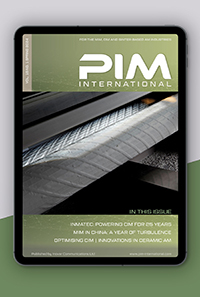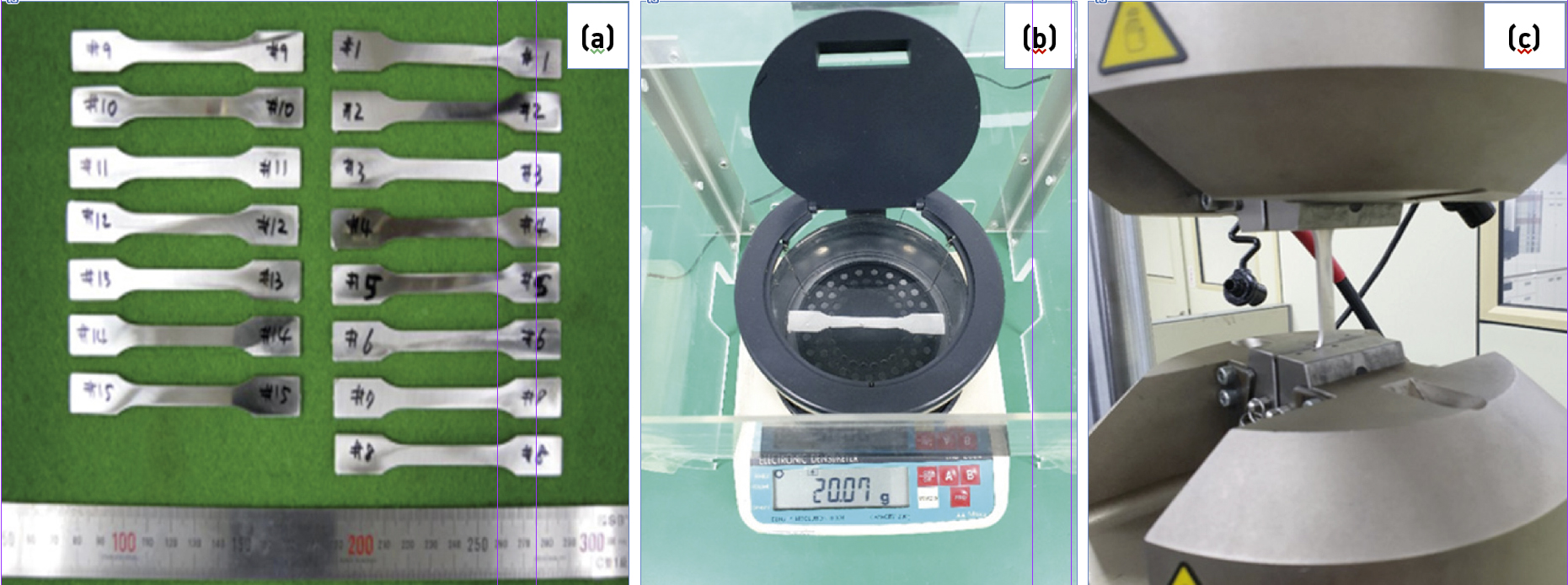MIM 316L stainless steel mechanical properties compared with other forming processes
July 4, 2023
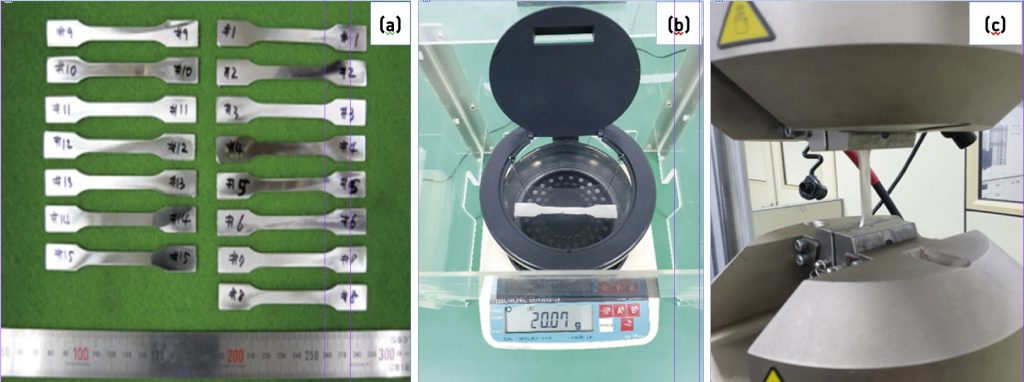
316L stainless steel is one of the most commonly used alloys in Metal Injection Moulding thanks to its excellent corrosion resistance, weldability and good mechanical properties. Typical applications consist of consumer products such as watchcases, spectacle frame parts, automotive components, electronics, dental and medical devices. MIM 316L stainless steel is said to have contributed significantly to the growth of the global MIM industry, which has seen average annual growth rates of around 14% over the past decade.
However, whilst MIM technology has advantages in terms of achieving shape complexity with minimum material waste in processing compared with other shaping processes, such as machining, investment casting and die casting, the mechanical properties of MIM 316L stainless steel are very much dependent on optimising the MIM process. In particular, mechanical properties of MIM 316L stainless steel are highly dependent on the final density and grain size achieved in the sintered parts and any defects occurring during the MIM process can have a detrimental effect on final properties.
Research at the Chungbuk National University, in Cheongju, and the Industrial Materials Processing R&D Department at Korea Institute of Industrial Technology (KITECH), in Incheon, Republic of Korea, has been undertaken to achieve a greater understanding of the mechanical properties, including fatigue strength, of MIM 316L stainless steel. The aim of the research was to allow MIM 316L stainless steels to be considered for application sectors requiring higher strength components, for example in agricultural machinery. The results of this research have been published in Materials, March 7, 2023, Vol 16, 2144, 12 pp, with the authors I-S Hwang, T-Y So, D-H Lee, and C-S Shin.
The authors stated that fifteen test bars were injection moulded from 316L stainless steel feedstock based on water atomised grade powders, with the test bars being debound at 900°C for 1 h in hydrogen followed by sintering at 1320°C for 2 h under vacuum. The mechanical properties of the sintered MIM 316L test bars were then compared with 316L cold-rolled parts and also with some 316L parts made by hot rolling or by PBF-LB Additive Manufacturing. The authors analysed the microstructure of the sintered 316L test pieces via scanning electron microscopy (SEM) and the grain size using the intercept method and EBSD calculations. Fig. 1 (a) shows the 316L specimens made by the MIM process.
The average density obtained in the sintering of the MIM 316L test pieces, measured using the Archimedes principle,was 7.56 g/ cm3, or 94.62% of theoretical. The authors suggested that the density achieved in the MIM process is greatly affected by the conditions of the binder composition in the 316L feedstock and the debinding and sintering processes, and that the lower sintered density compared with the cold rolling process could put the MIM 316L parts at a disadvantage in terms of mechanical properties. Fig. 1 (b) shows the electronic densimeter (md-200s) used to measure density.
Tensile testing (UTS) of the sintered MIM 316L specimens was performed to fracture at the constant speed of 5 mm/min for three specimens each. The fatigue tests were done at the stress ratio of 0.1 and were performed at completely reversed cyclic stresses using the servohydraulic fatigue testing system shown in Fig. 1 (c). The maximum stresses of the fatigue tests were set based on the UTS obtained in the tensile test. These stresses were set at 80% (432 MPa) and in increments down to 55% (297 MPa). The fatigue limit was determined as the stress value applied when the number of loading cycles went beyond 106 in this study.
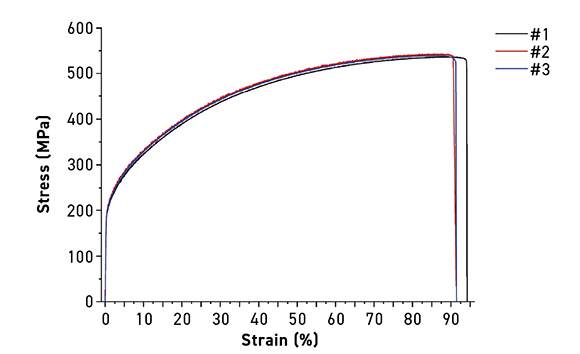
The average UTS value obtained from three of the MIM 316L samples tested was 539 MPa (Fig. 2). This is lower than the tensile strengths of the cold-rolled 316L specimens, which ranged from 620 to 795 MPa, and lower also than the hot-rolled specimen (580 MPa). Two mechanisms were identified by the authors as the primary causes of reduced mechanical properties in MIM 316L. The presence of pores in the sintered specimens caused by: (1) reduction in the area where stress is applied and (2) polygonal pores caused a notch effect, which could potentially lead to early material failure.
The ductility, or elongation to fracture, of the MIM 316L specimens was measured at 92%, which is a considerable increase compared to that of the cold-rolled specimen (30%) and was slightly higher than the hot-rolled specimen at 89%. Ductility could be increased further with an increase in sintering temperature to decrease porosity in the sintered material. However, the authors stated that sintering at excessively high temperatures could result in a decrease in ductility due to abnormal grain growth and the precipitation of carbides in the grain boundary. The temperature of 1320°C was therefore found to be optimal, with the sintered microstructure observed using SEM after etching showing average grain size to be 88.51 µm.
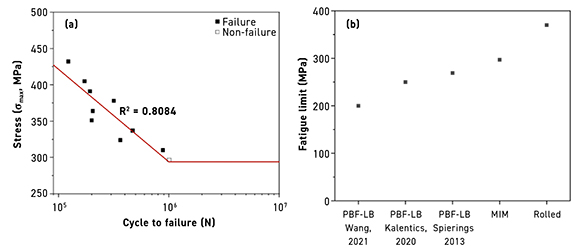
Fatigue testing was done on ten of the sintered MIM 316L test pieces. The fatigue test was performed at 80% of maximum tensile strength and a stress ratio of R = 0.1. The fatigue life was found at 55% (297 MPa) of maximum tensile strength that achieved 106 cycles. Fig. 3 (b) shows the results of the fatigue limit measurements for the MIM 316L and also the fatigue limits for rolled 316L and specimens produced by the PBF-LB Additive Manufacturing process. The fatigue limit for MIM 316was found to be higher than PBF-LB 316L and lower than cold-rolled 316L.
www.mdpi.com/journal/materials
Download PIM International magazine
